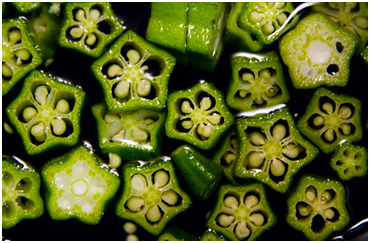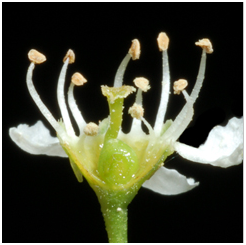The condition of stamens shown in the given picture is called:

1. Diadelphous
2. Polyadelphous
3. Syngenesious
4. Synandrous

Match each item in COLUMN I with one in COLUMN II and select the correct answer from the codes given:
|
|
COLUMN I [Cohesion of stamen] |
|
COLUMN II [Example] |
|
A. |
Monadelphoyus |
a. |
Sunflower |
|
B. |
Diadelphous |
b. |
China rose |
|
C. |
Syngenesious |
c. |
Cucurbits |
|
D. |
Synandrous |
d. |
Pea |
Codes
A B C D
1. b c d a
2. b d a c
3. c b a d
4. d c b a
Look at the dorsifixed condition of stamens in the given picture. This can also be seen in flowers of:

1. Mustard
2. Michelia
3. Passion flower
4. Salvia
What is the type of placentation seen in the given picture?

1. Marginal
2. Axile
3. Parietal
4. Basal
Identify the inflorescence:
| 1. | Raceme | 2. | Spike |
| 3. | Spikelet | 4. | Catkin |
Match each item in COLUMN I with one in COLUMN II and select the correct answer from the codes given:
|
|
COLUMN I [Racemose inflorescence] |
|
COLUMN II [Example] |
|
A. |
Spadix |
a. |
Wild coriander |
|
B. |
Corymb |
b. |
Sunflower |
|
C. |
Umbel |
c. |
Aroids |
|
D. |
Head/capitulum |
d. |
Candytuft |
Codes
A B C D
1. a b c d
2. b a d c
3. c d a b
4. d c b a
The given picture shows the stem modification in Asparagus racemosus. This is called as:
| 1. Phylloclade 2. Cladode 3. Phyllode 4. Bulbil |
 |
The internode eleongation of the thalamus seen in the picture is called as:

1. Anthophore
2. Androphore
3. Gynophore
4. Gynandrophore
Consider the given four statements:
| I: | Aggregate fruits develop from polycarpellary, apocarpous ovaries |
| II: | Composite fruit develops from inflorescence |
| III: | Parthenogenetic fruits develop from unfertilized ovaries |
| IV: | In false fruits, some of the flesh is not derived from the ovary, but from some adjacent tissue exterior to the carpel |
1. Only I, II and III are correct
2. Only I, III and IV are correct
3. Only I, II and IV are correct
4. Only II, III and IV are correct
What is the position of the ovary and the term for flower in the given figure?

1. Inferior, Epigynous
2. Superior, Hypogynous
3. Inferior, Hypogynous
4. Half-inferior, Perigynous







